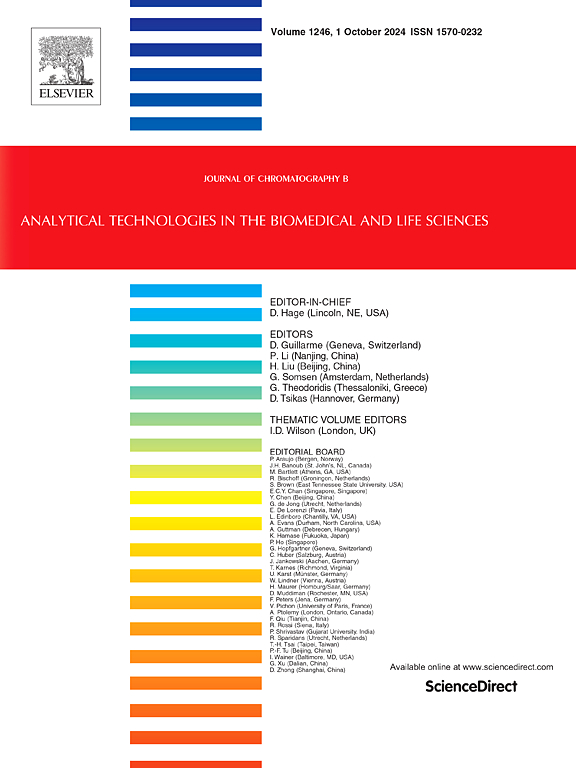7种丙炔联用抗叶酸抗生素在小鼠体内的比较药代动力学
IF 2.8
3区 医学
Q2 BIOCHEMICAL RESEARCH METHODS
引用次数: 0
摘要
对现有抗生素的抗菌素耐药性(AMR)是一项重大的全球卫生挑战,细菌感染引起的发病率和死亡率很高。耐甲氧西林金黄色葡萄球菌(MRSA)和万古霉素耐药菌株(VISA、VRSA)是最紧迫的威胁之一,特别是对脆弱人群而言。为了应对这一危机,开发新的治疗策略势在必行。我们报道了一类有前途的丙炔联二氨基嘧啶二氢叶酸还原酶(DHFR)抑制剂的药代动力学评价,这些抑制剂对耐药细菌(包括MRSA和VISA菌株)具有有效的活性。先前的研究表明,最低抑制浓度(MIC)值低于1 μg。mL−1为该系列的几种化合物。在这里,我们详细介绍了一种LC-QQQ生物分析方法的开发和验证,用于7种丙炔连接的二氨基嘧啶类似物。在小鼠模型中通过静脉注射(IV)、腹腔注射(IP)和口服(PO)途径进行的药代动力学研究显示,半衰期(t₁/ 2)、曲线下面积(AUC)和峰值血浆浓度(Cmax)等参数存在实质性变化。化合物38C1具有良好的溶解度,较高的最大耐受剂量和20%的口服生物利用度,使其成为主要候选药物。药代动力学与MIC比值分析显示,38C1在包括MRSA和VISA在内的多种金黄色葡萄球菌菌株中维持的血浆浓度显著高于MIC值。这些发现突出了38C1作为一种有希望进一步开发的抗叶酸候选药物。正在进行的研究将评估其在感染模型中的疗效,并改进给药策略,以最大限度地发挥治疗潜力,同时减轻耐药性的发展。本文章由计算机程序翻译,如有差异,请以英文原文为准。
Comparative pharmacokinetics of seven propargyl-linked antifolate antibiotics in the mouse
Antimicrobial resistance (AMR) to existing antibiotics poses a critical global health challenge, with significant morbidity and mortality from bacterial infections. Methicillin-resistant Staphylococcus aureus (MRSA) and vancomycin-resistant strains (VISA, VRSA) are among the most pressing threats, particularly for vulnerable populations. To combat this crisis, the development of novel therapeutic strategies is imperative.
We report the pharmacokinetic evaluation of a promising class of propargyl-linked diaminopyrimidine dihydrofolate reductase (DHFR) inhibitors with potent activity against drug-resistant bacteria, including MRSA and VISA strains. Previous studies have demonstrated minimum inhibitory concentration (MIC) values below 1 μg.mL−1 for several compounds in this series. Here, we detail the development and validation of an LC-QQQ bioanalytical method for seven propargyl-linked diaminopyrimidine analogues. Pharmacokinetic studies in a murine model across intravenous (IV), intraperitoneal (IP), and oral (PO) routes revealed substantial variability in parameters such as half-life (t₁/₂), area under the curve (AUC), and peak plasma concentration (Cmax).
Compound 38C1 demonstrated favorable solubility, a higher maximum tolerated dose, and oral bioavailability of 20 %, making it a lead candidate. Pharmacokinetic-to-MIC ratio analyses showed that 38C1 maintained plasma concentrations significantly above MIC values for multiple S. aureus strains, including MRSA and VISA.
These findings highlight 38C1 as a promising antifolate candidate for further development. Ongoing studies will assess its efficacy in infection models and refine delivery strategies to maximize therapeutic potential while mitigating resistance development.
求助全文
通过发布文献求助,成功后即可免费获取论文全文。
去求助
来源期刊

Journal of Chromatography B
医学-分析化学
CiteScore
5.60
自引率
3.30%
发文量
306
审稿时长
44 days
期刊介绍:
The Journal of Chromatography B publishes papers on developments in separation science relevant to biology and biomedical research including both fundamental advances and applications. Analytical techniques which may be considered include the various facets of chromatography, electrophoresis and related methods, affinity and immunoaffinity-based methodologies, hyphenated and other multi-dimensional techniques, and microanalytical approaches. The journal also considers articles reporting developments in sample preparation, detection techniques including mass spectrometry, and data handling and analysis.
Developments related to preparative separations for the isolation and purification of components of biological systems may be published, including chromatographic and electrophoretic methods, affinity separations, field flow fractionation and other preparative approaches.
Applications to the analysis of biological systems and samples will be considered when the analytical science contains a significant element of novelty, e.g. a new approach to the separation of a compound, novel combination of analytical techniques, or significantly improved analytical performance.
 求助内容:
求助内容: 应助结果提醒方式:
应助结果提醒方式:


